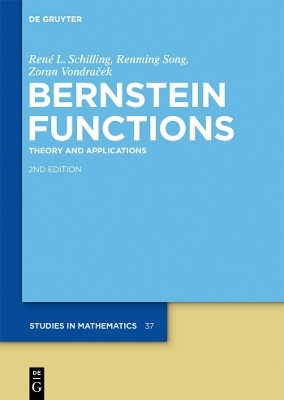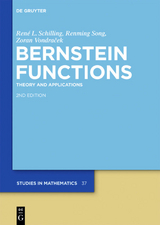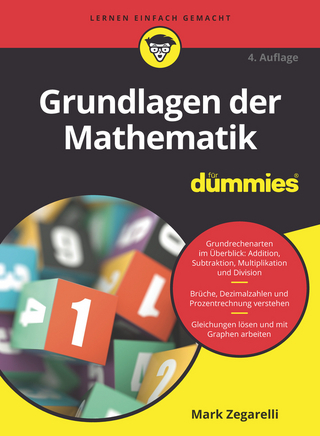Bernstein Functions
De Gruyter (Verlag)
978-3-11-025229-3 (ISBN)
Bernstein functions appear in various fields of mathematics, e.g. probability theory, potential theory, operator theory, functional analysis and complex analysis – often with different definitions and under different names. Among the synonyms are `Laplace exponent' instead of Bernstein function, and complete Bernstein functions are sometimes called `Pick functions', `Nevanlinna functions' or `operator monotone functions'. This monograph – now in its second revised and extended edition – offers a self-contained and unified approach to Bernstein functions and closely related function classes, bringing together old and establishing new connections. For the second edition the authors added a substantial amount of new material. As in the first edition Chapters 1 to 11 contain general material which should be accessible to non-specialists, while the later Chapters 12 to 15 are devoted to more specialized topics. An extensive list of complete Bernstein functions with their representations is provided.
René L. Schilling, Dresden University of Technology, Germany; Renming Song, University of Illinois, Urbana, USA; Zoran Vondraček, University of Zagreb, Croatia.
"To sum up, the book collects and integrates results from a number of sources scattered throughout the literature. It is clearly and carefully written. It will certainly be useful for both graduate students and researchers in different areas." Mathematical Reviews (review of the first edition)
"This impressive monograph, which is now in an expanded second edition, does a wonderful job of collecting together and synthesising some of the most important results and applications. Consequently it represents a unique perspective on this important function class which will be a valuable resource for many years to come for both experienced researchers and graduate students." Mathematical Reviews
| Erscheint lt. Verlag | 14.9.2012 |
|---|---|
| Reihe/Serie | De Gruyter Studies in Mathematics ; 37 |
| Zusatzinfo | 5 b/w ill., 10 b/w tbl. |
| Verlagsort | Berlin/Boston |
| Sprache | englisch |
| Maße | 170 x 240 mm |
| Gewicht | 836 g |
| Themenwelt | Mathematik / Informatik ► Mathematik ► Allgemeines / Lexika |
| Mathematik / Informatik ► Mathematik ► Analysis | |
| Schlagworte | Bernstein Function • Bernstein Function; Monotone Function; Probability Measure; Semigroup; Theory • Bernstein Funktion • Bernstein-Funktion • Mathematik • Monotone Function • Monotone Funktion • probability measure • Semigroup • theory |
| ISBN-10 | 3-11-025229-5 / 3110252295 |
| ISBN-13 | 978-3-11-025229-3 / 9783110252293 |
| Zustand | Neuware |
| Haben Sie eine Frage zum Produkt? |
aus dem Bereich




